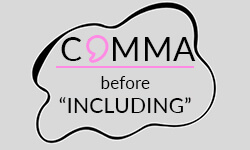
Commas and their rules often cause confusion among students, which then frequently results in errors in context and academic writing. Therefore, it is integral to familiarise yourself with the exact comma rules and exceptions to avoid ambiguity and promote clarity in your writing. The following article delves into using a comma before “including” with respective examples to help you implement cohesion and a proper understanding of your text.
When to place a comma before “including”
When the word “including” introduces a clause or additional information that is non-essential for the meaning of the whole sentence or context, a comma should be used before “including.” On the contrary, when “including” introduces extra information or a clause imperative to the meaning of the entire sentence, then the comma before “including” should be omitted.
Comma
Introducing non-essential clause
Introducing non-essential details
No comma
Introducing essential clause
Introducing essential details
Progressive form
For complex sentences, there may be exceptions to the comma rules. Furthermore, some rules may vary depending on different style guides. Generally, it is more common that a comma is placed before “including.” However, when in doubt, it is helpful to consider whether a clause or additional details can be omitted without changing the essence of a sentence. If so, the comma should be left out.
Comma before “including”
A comma before the word “including” is used when you are adding a non-essential clause or information that doesn’t alter the underlying meaning of the sentence. A comma is used to indicate a continuation of thoughts or a separation.
Introducing a non-essential clause
If the meaning of the sentence doesn’t change when adding or removing a non-essential clause, then a comma must be placed.
Introducing non-essential details
If the word “including” adds information or details that are non-essential to the meaning of the overall sentence, you should also place a comma before it.
No comma before “including”
A comma before the word “including” is not used if the phrase that is introduced serves an essential role regarding the meaning of the sentence.
Introducing an essential clause
If the meaning of the sentence changes when removing a clause introduced by “including,” the clause is essential and thus, a comma should be omitted.
Introducing essential details
No comma should be placed before “including” if the information that follows has an essential role in the meaning of the sentence.
“Including” in the progressive form
When introducing additional information or clauses for further clarification or to refer back to prior statements, the word “including” acts as a preposition. When “including” is used in the progressive form of the verb “to include,” there is also no comma placed before.
Test yourself!
Practice sheet
Place the commas in the appropriate places in each of the ten sentences to test your comprehension of how to use them correctly before “including.” To see if you have the right comprehension, look for the correct answers in the second tab.
- I love her including her quirks.
- She is including a singer in her wedding plans.
- He only likes beer including alcohol.
- I have been including dairy in meals for 17 years now.
- She washed her laundry including her bedsheets.
- My life is a mess including my love life.
- The company fired all of my coworkers including my best friend.
- The school uses techniques including group work.
- My grandmother is including all of her grandchildren in her last will.
- Society only functions by including all of its individual members.
- I love her, including her quirks. (Comma)
- She is including a singer in her wedding plans. (No comma)
- He only likes beer including alcohol. (No comma)
- I have been including dairy in meals for 17 years now. (No comma)
- She washed her laundry, including her bedsheets. (Comma)
- My life is a mess, including my love life. (No comma)
- The company fired all of my coworkers, including my best friend. (Comma)
- The school uses techniques including group work. (No comma)
- My grandmother is including all of her grandchildren in her last will. (No comma)
- Society only functions by including all of its individual members. (No comma)
- ✓ Free express delivery
- ✓ Individual embossing
- ✓ Selection of high-quality bindings
FAQs
You should use a comma before “including” when it introduces a non-essential clause or additional information that doesn’t change the basic meaning of the sentence. If the phrase beginning with “including” is essential for the meaning of the sentence, you shouldn’t use a comma.
The word “including” functions as a preposition when you aim to add details that are part of the topic you are discussing. “To include” acts as a verb and describes that something is being incorporated as part of a whole.
In a sentence, the word “including” can be used as a preposition introducing clauses or additional information, as well as, a verb in its progressive form.
Example
She loves many genres of music, including jazz, rock, and pop.
As this article describes, when “including” is used, it typically indicates that a list of information or a clause will follow, therefore, a colon after phrases like “such as,” “including,” and “for example” should be omitted.
